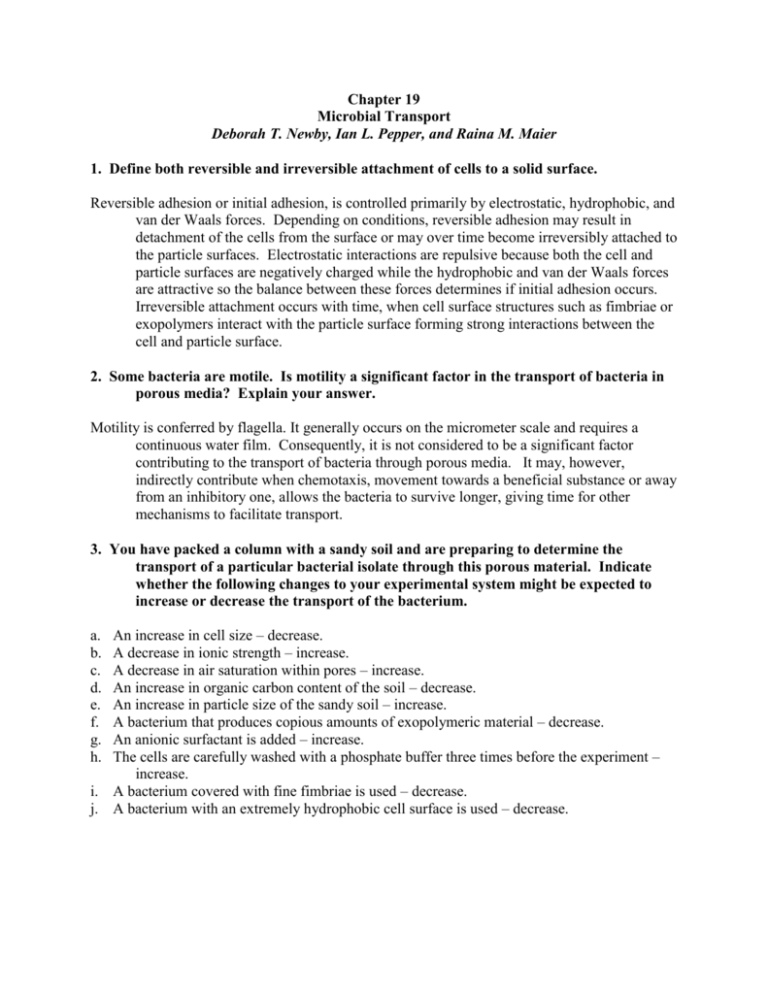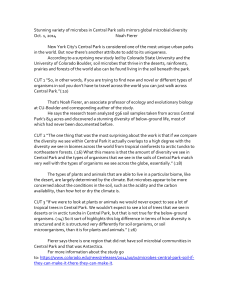Chapter 13, p 281
advertisement

Chapter 19 Microbial Transport Deborah T. Newby, Ian L. Pepper, and Raina M. Maier 1. Define both reversible and irreversible attachment of cells to a solid surface. Reversible adhesion or initial adhesion, is controlled primarily by electrostatic, hydrophobic, and van der Waals forces. Depending on conditions, reversible adhesion may result in detachment of the cells from the surface or may over time become irreversibly attached to the particle surfaces. Electrostatic interactions are repulsive because both the cell and particle surfaces are negatively charged while the hydrophobic and van der Waals forces are attractive so the balance between these forces determines if initial adhesion occurs. Irreversible attachment occurs with time, when cell surface structures such as fimbriae or exopolymers interact with the particle surface forming strong interactions between the cell and particle surface. 2. Some bacteria are motile. Is motility a significant factor in the transport of bacteria in porous media? Explain your answer. Motility is conferred by flagella. It generally occurs on the micrometer scale and requires a continuous water film. Consequently, it is not considered to be a significant factor contributing to the transport of bacteria through porous media. It may, however, indirectly contribute when chemotaxis, movement towards a beneficial substance or away from an inhibitory one, allows the bacteria to survive longer, giving time for other mechanisms to facilitate transport. 3. You have packed a column with a sandy soil and are preparing to determine the transport of a particular bacterial isolate through this porous material. Indicate whether the following changes to your experimental system might be expected to increase or decrease the transport of the bacterium. An increase in cell size – decrease. A decrease in ionic strength – increase. A decrease in air saturation within pores – increase. An increase in organic carbon content of the soil – decrease. An increase in particle size of the sandy soil – increase. A bacterium that produces copious amounts of exopolymeric material – decrease. An anionic surfactant is added – increase. The cells are carefully washed with a phosphate buffer three times before the experiment – increase. i. A bacterium covered with fine fimbriae is used – decrease. j. A bacterium with an extremely hydrophobic cell surface is used – decrease. a. b. c. d. e. f. g. h. 4. Compare and contrast the major factors influencing bacterial versus viral transport through the terrestrial profile. Which type of microbe would you expect to find deeper in the profile following surface application? A number of different factors influence the transport of both bacteria and virus through the terrestrial profile. The primary factor limiting bacterial transport is filtration, while for virus it is adsorption which is highly affected by pH and ionic strength of the soil solution. In general, one would expect that virus would be transported deeper in the profile following a surface application. 5. Choose either a bacterium or virus and design a column experiment to assess its transport potential. Your discussion should include items such as column design, type of matrix material, flow conditions, percolating solution, and inoculation and sampling approaches. Support your choices. A column experiment to assess transport of a bacterium through a saturated soil could be designed using the following approach. Soil could be collected from the site of interest and brought back to the lab or used as the column matrix. It may be helpful to have the soil characterized in terms of texture, soil pH, and organic matter content as these characteristics will have an influence on microbial transport. The soil should be sieved (to assure uniformity and reduce potential for preferential flow paths). Moisture content can be adjusted using a CaCl2 solution in order to prevent dispersion of soil particles, which could decrease soil permeability during subsequent percolation. The column could be Plexiglas and may be of dimensions on the order of 30.5 cm in length and an inner diameter of 7.5 cm (large enough to reduce effects of flow at along the soil-column interface). A membrane or plate should be added at the influent end to ensure even application of the percolating solution as well as the inoculum. Columns can be packed in layers using a tool with the same inner diameter as the column. The soil should be packed to a particle density similar to that found in the natural environment, typically around 2.65 g cm-3. The soil can be amended with a contaminant, such as 2,4dichlorophenoxyacetic acid, at a defined concentration prior to packing. Soil columns will be percolated by addition of the solution (again CaCl2 for the reason already stated) to the top of the column. A peristaltic pump can be used to deliver a consistent rate of percolation solution. Columns can be destructively sampled from the distal to the inoculated end by removal in the same layers as they were packed. This can be done using a spatula and carefully scraping to layers marked on the column. Soil from each layer can be homogenized via stirring and then microbes extracted and plated on media that is selected for the inoculum. 6. What are UMBs? How can they be used to facilitate bioremediation of contaminated sites? UMBs are ultramicrobacteria. These are typically bacterial cells that are roughly 1/3 their normal size, generally 0.3 μm in size, are relatively round, and have lost their capsule. Cells can be induced into this state by subjecting them to an extended period of starvation by placing them in a nutrient-deprived medium such as phosphate-buffered saline. UMBs can facilitate bioremediation since they are smaller, round, and less sticky, all factors that increase bacterial transport and thus dissemination throughout a contaminated site. Once introduced UMBs can be resuscitated by nutrient injection. They will then grow, divide, and metabolize the contaminant. Use of UMBs reduces injection site plugging, a common problem for many remediation sites. In addition, they may be used to create different flow paths as they grow and plug pores which can also facilitate remediation. 7. Since both soil particles and microbes generally have a net negative surface charge, why is sorption to matrix material often a factor limiting microbial transport? Although both soil particles and microbes generally have a net negative surface charge (and thus would be electrostatically repulsive), sorption to the matrix material is often a factor limiting microbial transport. This is due to a number of other factors besides charge that are attractive in nature and often outweigh the electrostatic repulsion. These include van der Waals forces, hydrophobic interactions, cation bridging, as well as cell surface properties such as expolymers and fimbriae. 8. Why do microbes introduced to a site often die within a few days to weeks? What impact does this have on the transport potential of the introduced microbes? Microbes often die within a few days to weeks of being introduced to a site because of suboptimal conditions including nutrient limitations, temperatures, competing microbes including protozoa, and water availability. If microbes die or are not very active once introduced into the environment, they are likely to break open releasing their DNA into the environment. The microbes themselves have a decreased transport potential, but their genetic material may be transported or sorbed to colloids where it may be protected from degradation. The DNA may also be taken up into other indigenous microbes and the transport potential of these microbes will be dependent on their properties. In some cases, genetic exchange into indigenous populations has resulted in the increased transport of genes of interest within these populations.






